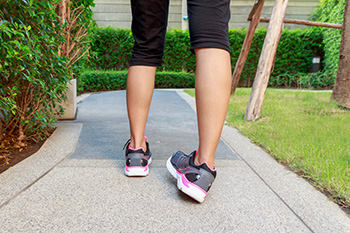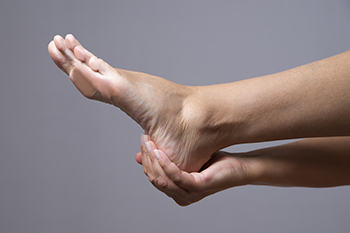Items filtered by date: December 2022
Reminder: When Was the Last Time...?
Heel Pain in Children May Indicate Sever’s Disease

A common reason for heel pain among active children and young teenagers is Sever's disease. The medical name for this condition is calcaneal apophysitis, and it affects the growth plate in the heel. Sever’s disease occurs during a growth spurt in this age group, where additional pressure is put on the heel, especially during the beginning of a new sporting season. The heel bone can grow at a faster speed than the tendons and muscles, and this can cause the heel to become less flexible. Common symptoms many children experience with this ailment can include heel pain and swelling, often causing the need to temporarily stop the activity that caused the condition. There may be additional reasons why Sever’s disease can develop, consisting of having one leg that is shorter than the other, or if the arches are abnormal. Relief can begin by frequently elevating the affected foot which may alleviate some of the swelling, and performing specific stretches that can strengthen the foot. If your child is afflicted with Sever’s disease, it is strongly urged that a podiatrist is consulted who can offer correct treatment methods.
Sever's disease often occurs in children and teens. If your child is experiencing foot or ankle pain, see James Pak, DPM from California. Our doctor can treat your child’s foot and ankle needs.
Sever’s Disease
Sever’s disease is also known as calcaneal apophysitis, which is a medical condition that causes heel pain I none or both feet. The disease is known to affect children between the ages of 8 and 14.
Sever’s disease occurs when part of the child’s heel known as the growth plate (calcaneal epiphysis) is attached to the Achilles tendon. This area can suffer injury when the muscles and tendons of the growing foot do not keep pace with bone growth. Therefore, the constant pain which one experiences at the back of the heel will make the child unable to put any weight on the heel. The child is then forced to walk on their toes.
Symptoms
Acute pain – Pain associated with Sever’s disease is usually felt in the heel when the child engages in physical activity such as walking, jumping and or running.
Highly active – Children who are very active are among the most susceptible in experiencing Sever’s disease, because of the stress and tension placed on their feet.
If you have any questions, please feel free to contact our office located in Anaheim, CA . We offer the newest diagnostic and treatment technologies for all your foot and ankle injuries.
Dealing With Ankle Sprains

Ankle pain is a common occurrence, which shouldn’t be surprising because the ankle is involved in every step you take. Ankle injuries are usually caused by tripping on a step or curb or twisting the ankle during a sports activity. This can result in a ligament sprain. With an ankle sprain, the foot rolls inward and the ankle outward, thereby stretching a ligament beyond its normal range. Symptoms include pain, swelling, redness, and warm when touched. Some stiffness may follow. Ankle sprains often interfere with bearing weight on the affected foot. If you are in extreme pain from an ankle injury and cannot put weight on that foot, please seek medical help immediately. The first thing to do is stay off the affected ankle, keep it elevated, and put ice on it to help reduce the swelling. Seeing a podiatrist as soon as possible is suggested to determine the severity and extent of the injury. Healing from an ankle injury can take weeks or even months. Braces or other walking devices may be prescribed to allow the ankle to move while keeping it stable. Allowing the ankle to fully heal is imperative for avoiding re-injury or chronic ankle problems in the future. For more information, please contact a podiatrist.
Although ankle sprains are common, they aren’t always minor injuries. If you need your ankle injury looked at, contact James Pak, DPM from California. Our doctor can provide the care you need to keep you pain-free and on your feet.
How Does an Ankle Sprain Occur?
Ankle sprains are the result of a tear in the ligaments within the ankle. These injuries may happen when you make a rapid shifting movement while your foot is planted. A less common way to sprain your ankle is when your ankle rolls inward while your foot turns outward.
What Are the Symptoms?
- Pain at the sight of the tear
- Bruising/Swelling
- Ankle area is tender to touch
- In severe cases, may hear/feel something tear
- Skin discoloration
Preventing a Sprain
- Wearing appropriate shoes for the occasion
- Stretching before exercises and sports
- Knowing your limits
Treatment of a Sprain
In many cases, the RICE method (Rest, Ice, Compression, and Elevate) is used to treat ankle sprains. However, you should see a podiatrist to see which treatment option would work best with your injury. In severe cases, surgery may be required.
It is important to ask your doctor about rehab options after you receive treatment for your injury. Stretching, strength training, and balance exercises may help the ankle heal while also preventing further injury.
If you have any questions, please feel free to contact our office located in Anaheim, CA . We offer the newest diagnostic and treatment technologies for all your foot care needs.
Can Heel Pain Be Prevented?

Heel pain and running are not compatible. It can be a runner’s worst nightmare, and it is beneficial to learn how to prevent heel pain from developing. It is believed that heel pain can happen from the heels enduring more pressure than they are prepared for, and this can be easily avoided when proper warm-ups and cool-downs are performed. Additionally, specific heel and calf stretches can make the entire leg stronger, and this can begin with the feet. An effective heel stretch is done by standing on a step and lowering one heel at a time until a gentle pull is felt. Some patients find it helpful to perform toe yoga, which is done by keeping the heel stationary while lifting the toes off of the floor. Research has shown that heel pain may be linked to weakened foot muscles, and there are various stretches and exercises that can strengthen the feet. If you have heel pain, it is strongly urged that you are under the care of a podiatrist who can determine the cause, and offer you helpful treatment options.
Many people suffer from bouts of heel pain. For more information, contact James Pak, DPM of California. Our doctor can provide the care you need to keep you pain-free and on your feet.
Causes of Heel Pain
Heel pain is often associated with plantar fasciitis. The plantar fascia is a band of tissues that extends along the bottom of the foot. A rip or tear in this ligament can cause inflammation of the tissue.
Achilles tendonitis is another cause of heel pain. Inflammation of the Achilles tendon will cause pain from fractures and muscle tearing. Lack of flexibility is also another symptom.
Heel spurs are another cause of pain. When the tissues of the plantar fascia undergo a great deal of stress, it can lead to ligament separation from the heel bone, causing heel spurs.
Why Might Heel Pain Occur?
- Wearing ill-fitting shoes
- Wearing non-supportive shoes
- Weight change
- Excessive running
Treatments
Heel pain should be treated as soon as possible for immediate results. Keeping your feet in a stress-free environment will help. If you suffer from Achilles tendonitis or plantar fasciitis, applying ice will reduce the swelling. Stretching before an exercise like running will help the muscles. Using all these tips will help make heel pain a condition of the past.
If you have any questions please contact our office located in Anaheim, CA . We offer the newest diagnostic and treatment technologies for all your foot and ankle needs.
All About the Arches of the Feet

The arches of the feet work as a spring that bears the weight of your body whenever you take a step. Most people are familiar with the arch on the inner sole of the midfoot. However, three separate arches combine to form a triangle in the feet that absorb the shock of walking and running. There are two longitudinal arches, medial and lateral, that run along either side of the foot from the heel to the top of the 1st and 5th metatarsal. Plus there is a transverse arch that runs across the midfoot, connecting the tops of the metatarsals. These three arches are supported by a number of ligaments, muscles, tendons, and bones that all help to support the weight of the body. When the medial longitudinal arch is too high, it causes a condition called pes cavus, which can be painful and cause gait problems. When the longitudinal arches collapse, it results in flat feet, known as pes planus. Both conditions, which can affect the way you carry out your daily activities, can be diagnosed and treated by a podiatrist.
If you have any concerns about your feet, contact James Pak, DPM from California. Our doctor can provide the care you need to keep you pain-free and on your feet.
Biomechanics in Podiatry
Podiatric biomechanics is a particular sector of specialty podiatry with licensed practitioners who are trained to diagnose and treat conditions affecting the foot, ankle and lower leg. Biomechanics deals with the forces that act against the body, causing an interference with the biological structures. It focuses on the movement of the ankle, the foot and the forces that interact with them.
A History of Biomechanics
- Biomechanics dates back to the BC era in Egypt where evidence of professional foot care has been recorded.
- In 1974, biomechanics gained a higher profile from the studies of Merton Root, who claimed that by changing or controlling the forces between the ankle and the foot, corrections or conditions could be implemented to gain strength and coordination in the area.
Modern technological improvements are based on past theories and therapeutic processes that provide a better understanding of podiatric concepts for biomechanics. Computers can provide accurate information about the forces and patterns of the feet and lower legs.
Understanding biomechanics of the feet can help improve and eliminate pain, stopping further stress to the foot.
If you have any questions please feel free to contact our office located in Anaheim, CA . We offer the newest diagnostic and treatment technologies for all your foot and ankle needs.

